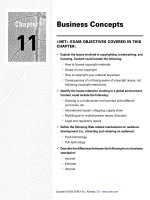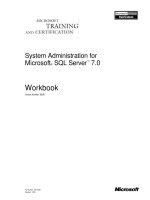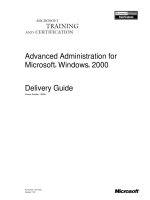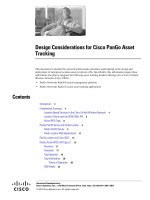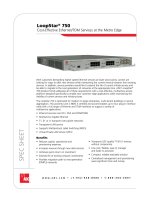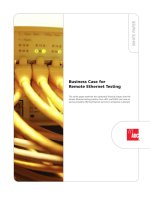Tài liệu Business Case for Remote Ethernet Testing docx
Bạn đang xem bản rút gọn của tài liệu. Xem và tải ngay bản đầy đủ của tài liệu tại đây (680.07 KB, 11 trang )
Business Case for
Remote Ethernet Testing
This white paper examines the substantial financial impact that the
remote Ethernet testing solution from ADC and EXFO can have on
service providers offering Ethernet services to enterprise customers.
WHITE PAPER
Introduction
As revenues from traditional circuit-switched voice lines steadily decrease, service
providers recognize that Ethernet access and related services represent the
future. As a result, they are shifting investment away from legacy data services
such as ATM or Frame Relay and towards flexible Ethernet access solutions.
But service providers face a variety of technical challenges when deploying
Ethernet networks, and these issues can cause significant increases in
operational expenses. In particular, Ethernet commissioning and maintenance
have been expensive endeavors compared to traditional alternatives. A lack of
deployed remote test solutions frequently results in on-location troubleshooting
and maintenance. This time-consuming activity adds up to high support costs.
The recent ratification of the IEEE 802.3ah Ethernet in the First Mile (EFM)
testing standard offers significant opportunities for service providers to reduce
operational expenses and more quickly deploy Ethernet services. Test solutions
based on the 802.3ah guidelines address all of the key challenges commonly
encountered with Ethernet service deployment: reliability, performance, Quality
of Service (QoS), SLA assurance, and network troubleshooting.
To address these critical issues, ADC and EXFO have created a two-component
802.3ah-compliant remote testing solution using the ADC Ethernet Network
Interface Unit (ENIU) and EXFO’s Packet Blazer™ Gigabit Ethernet tester.
Remote testing using the solution from ADC and EXFO results in significant
financial benefits for service providers—network downtime is significantly
reduced, Service Level Agreements (SLAs) are assured, and customer retention is
increased. This white paper examines these benefits in detail.
Business Case for
Remote Ethernet Testing
Business Case for Remote Ethernet Testing
Page 2
ROI Methodology and Highlights
ADC and EXFO collaborated with an independent
research organization which specializes in ROI and cost
benefit analysis to perform an objective study of the
financial returns generated by the deployment of their
Ethernet testing solution. The scenario examines the
results and return on investment for a service provider
deploying 10 EXFO Packet Blazers™, each used in
conjunction with 40 ADC Ethernet Network Interface
Units (ENIUs), for a total of 400 remotely accessible
customer installations. The ROI scenario scales with size,
so larger deployments, for example, will realize greater
gains.
A detailed business analysis of the solution reveals the
following highlights, based on a five-year study period:
• The cumulative net value of the solution is projected in
excess of $735,000, driven by operational (OPEX)
savings and SLA penalty avoidance.
• The cumulative OPEX savings are greater than
$642,000.
• The savings in avoided SLA penalties totals more than
$330,000.
• The return on investment will exceed 400%, with a
payback period less than 16 months.
Challenges with Deployment of
Ethernet Services
For service providers, the writing is on the wall—deploy
Ethernet services or lose business and miss out on an
expanding market. Customers are demanding more
bandwidth at increasingly lower price points, and with
Ethernet offerings from traditional carriers, multi-service
operators (MSOs), cable and internet providers, there are
plenty of competitive choices to choose from.
Ethernet is the least-expensive way to offer low-cost
bandwidth. It is a mature, plug-and-play technology that
integrates easily into corporate LANs. Ethernet has other
benefits for service providers in addition to its low cost.
It allows carriers to easily scale bandwidth to the exact
amount requested by customers—it can be charged in
increments, and upgraded in increments as well. By way
of contrast, legacy services are not easily scaled. T1 lines,
for example, can only be incremented in multiples by
installing and testing an additional line—a lengthy,
expensive procedure.
The growth of Ethernet services also represents a
significant revenue opportunity for access providers. The
expansion of metro Ethernet services will lead to
extensions in WAN applications including Ethernet Private
Lines, Ethernet Internet Access, and Virtual Private LAN
Services (VPLS)—a pattern that fuels additional demand
for infrastructure and services. Ethernet services are
growing at a fast clip, with an estimated global market
of $22 billion by 2009
1
.
There are issues with Ethernet deployment as it moves
from the LAN to the WAN via metro access networks.
Ethernet is typically implemented as a “best-effort”
service, and traditionally has not met mission-critical
reliability. Yet customers migrating to Ethernet access
lines expect the same availability and service guarantees
as frame relay, ATM, T1, and other legacy services which
have extensive management tools available to assure
service quality. Without remote test and monitoring, it is
difficult for service providers to commit to and meet SLAs
which can differentiate their offerings and assure
customers that their Ethernet services are business-class.
The Ethernet Testing Solution from ADC
and EXFO
Until recently, Ethernet commissioning and maintenance
were expensive endeavors compared to traditional
alternatives. The challenges faced by Ethernet service
providers result in high operations and maintenance
costs. The most common challenges are (Yankee Group,
2003):
• Performance problems (latency, packet loss, decreased
throughput, etc.)
• Assuring the reliability of routers and other multi-
service equipment
• Maintaining QoS/assurance of SLAs
• Element management and troubleshooting
As with legacy services, these problems are best
overcome with standards-based monitoring and remote
test tools. The recent ratification of the IEEE 802.3ah
Ethernet in the First Mile (EFM) testing standard offers
significant opportunities for service providers to more
quickly deploy Ethernet services and reduce their
operating expenses. The 802.3ah standard was modeled
after legacy service management, allowing test solutions
based on these guidelines to be easily integrated into
existing operational support and element management
systems.
ADC and EXFO have released a joint solution for remote
Ethernet testing based on 802.3ah that offers significant
benefits to service providers. Its remote troubleshooting
abilities result in fewer truck rolls. Because it can perform
single-ended testing, it allows faster turn-up and
restoration of services. Its proactive network
management can reduce network downtime and
increase network availability. Finally, standards compliance
allows easy integration into existing operational practices.
1
Infonetics Research (May 2005)
The solution is made up of two components: the ADC Ethernet Network Interface Unit (ENIU) and the EXFO Packet
Blazer Gigabit Ethernet test set. The ADC ENIU is installed at remote locations between customer LANs and access switch
ports, defining demarcation points between a provider’s network and its clients. Typical ENIU installations are shown in
the diagrams below.
The ENIU supports remote loopback, remote alarm indication, media conversion, bandwidth provisioning and link
monitoring. EXFO’s Packet Blazer offers a complete Ethernet test suite, including frame analysis, packet jitter, latency,
throughput, and bit error rate testing. By activating an ENIU’s loop-back mode, the Packet Blazer can remotely test the
provider’s network up to the given customer location.
How the Solution Is Used
When a customer reports a problem with an Ethernet service, the cause is often related to events or constraints within
the customer’s network. Remote testing with the solution from ADC and EXFO allows service providers to quickly
segment the network up to the customer premises and subsequently determine if a network issue is within the access
line (service provider’s responsibility) or related to customer-side problems (no further support required). This technique
significantly reduces truck rolls to customer premises and results in faster problem resolution. If the issue is found to be
within the provider’s network, the Packet Blazer can be used to remotely diagnose the problem, speeding service
restoration and minimizing on-site maintenance costs.
Business Case for Remote Ethernet Testing
Page 3
Metro
Network
X-Base-SX or LX
Fiber
X-Base-TX
UTP Copper
10/100/1000 Mbps
Ethernet Link
10/100/1000 Mbps
Ethernet Link
Enterprise
Demarcation
Point
Provider
Network
Customer
Network
Carrier
Provided
Switch
Customer
Provided
Switch
ENIU
GigE
Access Link
200 Mbps
100 Mbps
10 Mbps
Demarcation
Point
Carrier
Provided
Switch
Customer
2
Customer
1
Customer
3
ENIU
ENIU
ENIU
Typical ENIU installation on an Ethernet access line. Although this diagram depicts an optical network interface,
the ENIU can be deployed with optical and/or electrical interfaces on the network and customer sides.
As an alternative deployment, several ENIUs can be connected to a single carrier-provided switch to provide
separate demarcations when there are multiple customers connected to a single access link.
Business Case for Remote Ethernet Testing
Page 4
In recent studies with North American multi-service operators, maintenance costs associated with Ethernet services were
reduced by up to 50% when 802.3ah remote test solutions were implemented
2
.
Remote testing can also be used for commissioning, monitoring, and SLA management. As an example, remote
bandwidth provisioning is a unique, revenue-generating feature of Ethernet which can be greatly simplified using
802.3ah-based remote testing tools. When a customer requests additional bandwidth, the related ENIU is remotely
instructed to increase throughput on the access link. The ENIU is then put into loop-back mode and remote Ethernet
performance tests are conducted to ensure that the expected bandwidth will be met by the backhaul/access network. A
series of simulations are then conducted to ensure that revised SLA parameters will be met under various customer traffic
conditions. With the new bandwidth assured and commissioned, the ENIU is returned to pass-through mode and the
customer benefits from the upgraded link.
The following figures illustrate three different possible ways the solution can be used.
2
Light Reading, Feb. 2004
Central Office
Metro Network
SONET/SDH/DWDM
Ethernet tester
Ethernet
Switch
Customer
Premise
ENIU
Remote
Management
NOC
Remotely troubleshooting performance on a link or provisioning bandwidth from a central office with
customer-site ENIU in loop-back mode


